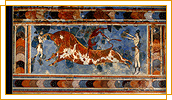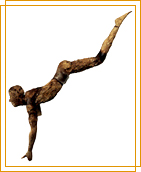Bull-leaping
Bull-leaping was a complex and dangerous acrobatic game during which
young men mostly and women would perform spectacular leaps on the
back of running bulls.  Naturally, using the bulls required catching
them and taming them. Although bull games were known in other prehistoric
cultures as well - such as the Egyptian - it is the Minoans who
reached the highest level of competency in this sport. It is thought
that kybistema (somersault) - a form of acrobatic technique
originating from Egypt - lies in the origins of the evolution of
bull-leaping. The performers of somersault were young men that performed
spectacular exercises with incredible flexibility. At times they
performed among swords. Naturally, using the bulls required catching
them and taming them. Although bull games were known in other prehistoric
cultures as well - such as the Egyptian - it is the Minoans who
reached the highest level of competency in this sport. It is thought
that kybistema (somersault) - a form of acrobatic technique
originating from Egypt - lies in the origins of the evolution of
bull-leaping. The performers of somersault were young men that performed
spectacular exercises with incredible flexibility. At times they
performed among swords.
Bull-leaping is well-studied by scholars specialized in Minoan studies. J. C Younger has studied a sample of fifty-four bull-leaping scenes and classified them on the basis of three different jumping techniques.  In Technique I, the athlete seized from the horns the galloping bull, flipped over its head, landed onto its back and then flipped over the rear of the bull on the ground. In Technique II, the athlete jumped preferably from an elevated position over the head of the bull, landed on his hands on the back of the bull and then flipped backwards and landed on his feet behind the bull. In Technique III, which can be found only in one representation, the athlete is depicted in a single pose above the tail of the bull, probably after having approached the animal from the side. Perhaps the latter technique is a non-realistic stance entailed by the needs of sealstone iconography. The famous frescoes from Knossos (ca. mid. 15th century BC) seem to be a combination of the first two techniques. In Technique I, the athlete seized from the horns the galloping bull, flipped over its head, landed onto its back and then flipped over the rear of the bull on the ground. In Technique II, the athlete jumped preferably from an elevated position over the head of the bull, landed on his hands on the back of the bull and then flipped backwards and landed on his feet behind the bull. In Technique III, which can be found only in one representation, the athlete is depicted in a single pose above the tail of the bull, probably after having approached the animal from the side. Perhaps the latter technique is a non-realistic stance entailed by the needs of sealstone iconography. The famous frescoes from Knossos (ca. mid. 15th century BC) seem to be a combination of the first two techniques.
Performers of bull-leaping, as appearing in the frescoes, are often characterized as noblemen, on the basis of their rich attire, their elaborate coiffure and jewels. It is thought by many researchers that bull-leaping was performed as part of religious rites aiming at the emergence of the best athletes. The religious character of the sport in mostly appears in the use of the bull, the sacred animal of the Minoans. It is most likely that bull-leaping was performed in especially fenced enclosures near the Palaces, as in Malia, where a specially prepared ground was found to the northwest, rather than in their central courtyards.
|
